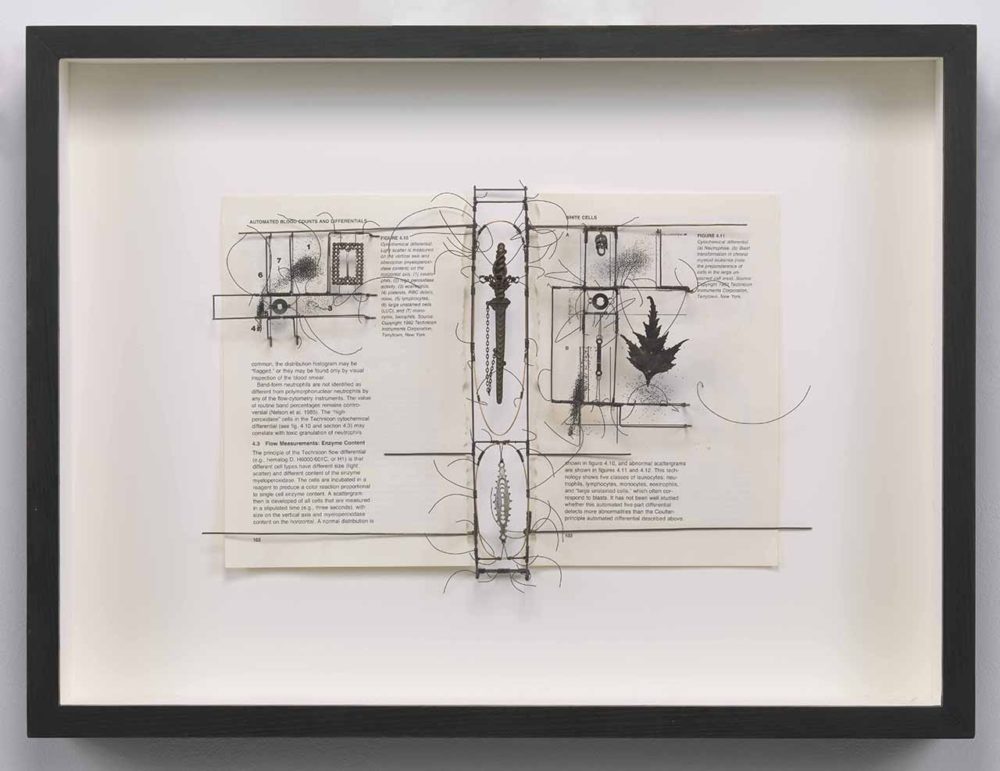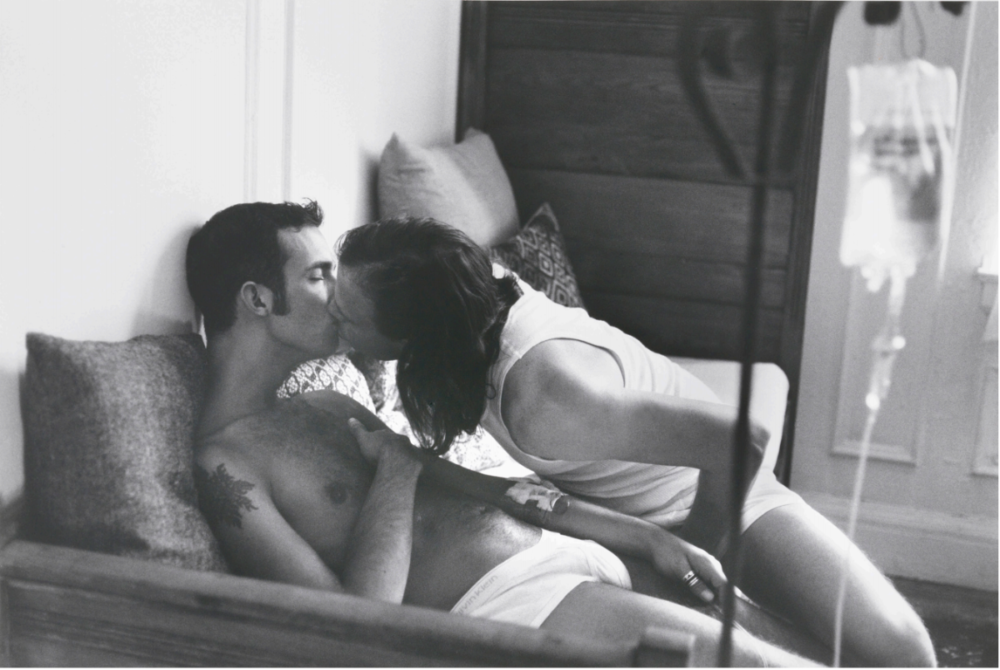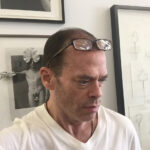In Rhein’s 1998 work, Uncle Lige’s Sword, a mixed media assemblage presents book pages, wire, and found objects, forming what appears to me a book laid open. The center of the work, perhaps read as the book’s spine, contains his uncle’s brooch, a small sword. As with much of Rhein’s work, the suggestive translucence of wire implies both an exterior and an interior—the spine of the book and its internal pages simultaneously face us. It seems apt that this work takes the potential shape of a book, given the role Clarke’s publications have played in Rhein’s life. It also seems fitting that Rhein’s work takes the form of a book in Lifelines. He treated this book like one of his artworks, thinking through placement and design like a sculpture.
While Lifelines gives us a view into Rhein’s more familiar sculptural work, it draws more heavily on an archive of images—self-portraits that Rhein began taking in 1992, as well as photographs of lovers and friends. Almost always, the bodies in these images are nude or nearly so, sometimes tender, pensive, playful, erotic—still graceful, like Rhein’s sculptures. Their settings might be bedrooms, barns, woods, and showers. Not only a presentation of Rhein’s work, this book serves as a visual memoir of Rhein’s life since his diagnosis. To an unknowing viewer (and even a knowing one), the photographs might serve as a bridge between Rhein’s life experiences and the sculptures whose messages read less explicitly.
The photo that graces the front jacket of this book, Company (1998), echoes Rhein’s Leaves project, though the two were not made in conscious connection. Company shows Rhein’s body at the center of the image, his torso upright as the trees behind him tilt in vertigo. His left forefinger and thumb grasp the base of a fallen leaf. Both hand and leaf are drenched in sunlight, casting a shadow onto Rhein’s sternum. Flecks of light pour through the deciduous holes in the leaf. The shadow is both an absence and a presence, not unlike his Leaves series where delicate wire retains only an outline of a leaf, like a line drawing. Each wire leaf cannot claim to fill the entirety of a life, only its outlines in memory. Rhein confesses to me that the title “company” refers to the company of spirits, of energies that can still be felt even if no longer quite seen; the company of the forest and of the woods. For Rhein, Leaves began when he felt the energy fields of those who’ve died from HIV/AIDS around him in nature. Each leaf visualizes some sense of their continuing company.
In another photograph, Negative Space (1993) Jeffery Albanesi, a furry, svelte figure, holds a rectangular paper with a leaf’s shape cut out in its center. The black paper covers part of Jeffery’s body to expose a leaf composed of his own chest, as though his hair was the leaf’s texture, its visual flatness betrayed by the shadow cast from his right pectoral. His cock hangs at the bottom of the image, severed by the frame of the photograph. Rhein was Jeffrey’s first boyfriend, and the “negative” in the title is a reference to Jeffrey’s negative serostatus. When paired with Company, Rhein’s self-portrait with a leaf might signal his positive serostatus, as well. Rather than the absence of a leaf in the portrait of Jeffrey, Rhein’s self-portrait displays a leaf in whole, a presence, a company. In both images, Eric and Jeffrey tilt their heads down toward their respective leaves.
A number of the images in this book were printed from negatives that Rhein revisited for the publication. In retrospect, these images became documents of Rhein’s intimacies with himself and others. Rhein first began taking self-portraits with a 35mm Nikon given to him by his mother. His then-boyfriend was a fashion illustrator, and so fashion photography surrounded them, inspiring him to begin documenting himself with a camera. Rhein’s own writing in Lifelines, “Notes from My Treehouse” is another document of his life, a short form essay that weaves expressions, memories, mantras, moving in and out of hospital visits, birthday parties, holidays, experiences with family members, friends, the Catskills, Kentucky, New York City, and so on. Accompanying Rhein’s work and words are two texts written by Paul Michael Brown and Mark Doty, intergenerational interlocutors, providing additional reflection, impression, and context for Rhein’s work.
Reading the word “lifeline”, the book’s title, I’m struck by the many lines running through this book, visually and conceptually: IV tubing, veins, branches, wire, willows, cracks in a broken mirror, the legacy of an activist blood-line, the frame of a photograph (a line of suspension, of fragmenting, of containing), the thread that binds this book, piercing and organizing its paper, interrupting images of found tree bark littering Rhein’s studio space. In Lifelines, Rhein employs the line to trace his own life and those who have impacted it, giving shape to memories. The different expressions of Rhein’s artistic practice compiled in this publication exemplify the throughlines in his work—the interconnectedness of nature, spirit, the body, and the commingling of sexuality, illness, and care.
Noam Parness is an assistant curator at the Leslie-Lohman Museum of Art. Recent curatorial projects include Uncanny Effects: Robert Giard’s Currents of Connection (2020, co-curated with Ariel Goldberg) and Haptic Tactics (2018, co-curated with Risa Puleo and Daniel J Sander), among others. They are co-editor of Queer Holdings (2019, Hirmer Publishers).












